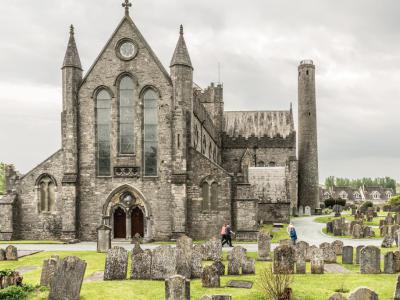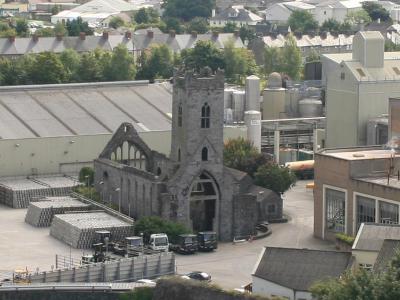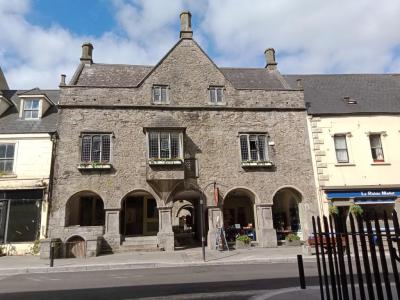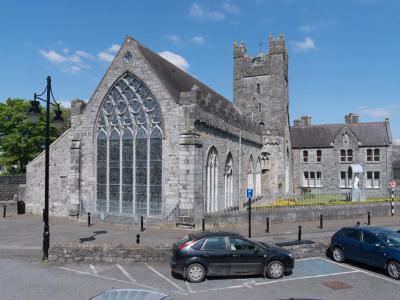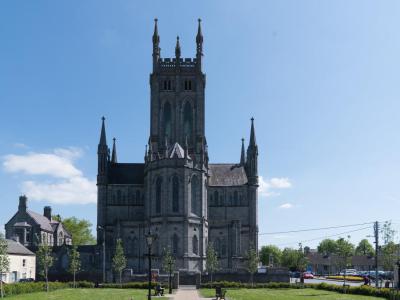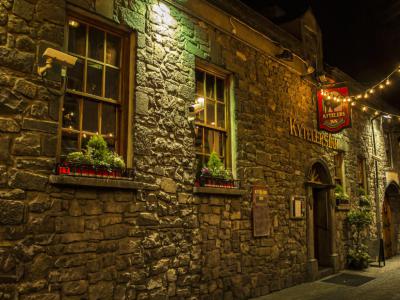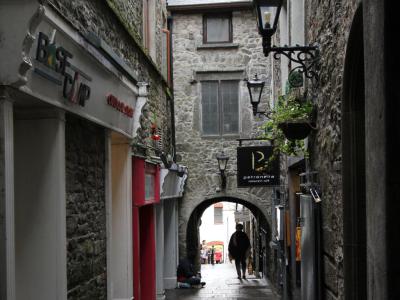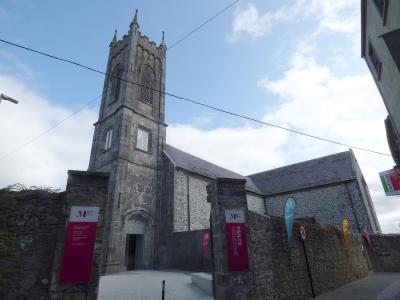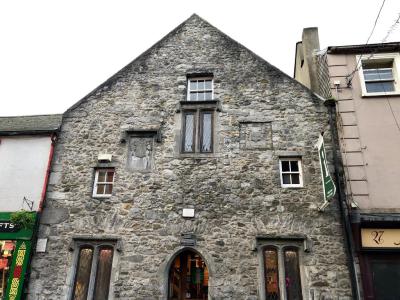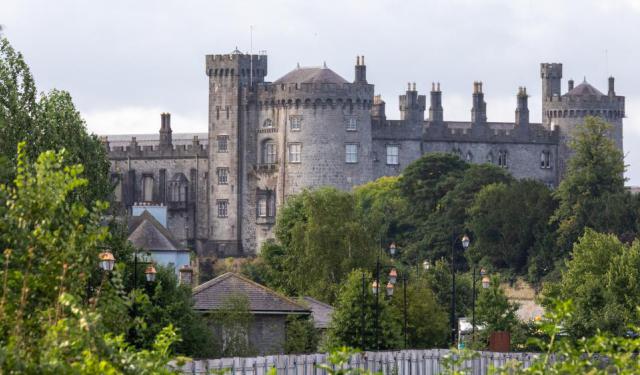
Kilkenny Introduction Walking Tour (Self Guided), Kilkenny
Situated some 90 minutes away from busy Dublin, the sleepy town of Kilkenny rests gracefully along the banks of the River Nore in the southeastern part of Ireland, exuding an ambiance of old-world charm.
The town's name is the anglicized version of the Irish "Cill Chainnigh," which means "Church of Canice." It pays homage to Saint Canice, an Ulsterman, a revered figure in Irish history; his legacy is still evident today on the hill containing Saint Canice's Cathedral and the Round Tower, both of which date back to the 13th century.
Kilkenny itself began with an early 6th-century ecclesiastical foundation within the Kingdom of Ossory. Following the 12th-century Norman invasion of Ireland, Kilkenny Castle and a series of walls were built to protect the burghers of what became a Norman merchant town. William Marshall, Lord of Leinster, gave Kilkenny a charter as a town in 1207. By the late 13th century, Kilkenny was under Hiberno-Norman control.
Saint Francis Abbey, founded around the same time by the Franciscan order, is another significant historical site in Kilkenny. It bears witness to the city's medieval heritage and offers a glimpse into the religious life of that era.
In 1609, King James I of England granted Kilkenny a Royal Charter, giving it the status of a city. Following the Irish Rebellion of 1641, the Irish Catholic Confederation, also known as the "Confederation of Kilkenny", was based in the city and lasted until the Cromwellian conquest of Ireland in 1649.
Kilkenny was a brewing center from the late 17th century and still houses a number of breweries. For those seeking to explore its brewing history, the Smithwick's Experience Kilkenny is a must-visit. Here, you can discover the story of Ireland's oldest ale, dating back over 300 years.
Kilkenny Courthouse is a striking neoclassical building that showcases the city's commitment to justice and governance. Nearby, Rothe House is a beautifully preserved 16th-century merchant's townhouse that provides a captivating insight into Kilkenny's past.
The Black Abbey, Saint Mary's Cathedral, and Kyteler’s Inn are more architectural gems that tell the tale of Kilkenny's ecclesiastical and social history.
Indeed, in Kilkenny, history permeates every nook and cranny. The slew of local attractions makes it worthy of a visit at all times of the year, especially during summer. So, why not embark on an adventure that awaits in this gem of the Emerald Isle? Come and discover the magic of Kilkenny for yourself!
The town's name is the anglicized version of the Irish "Cill Chainnigh," which means "Church of Canice." It pays homage to Saint Canice, an Ulsterman, a revered figure in Irish history; his legacy is still evident today on the hill containing Saint Canice's Cathedral and the Round Tower, both of which date back to the 13th century.
Kilkenny itself began with an early 6th-century ecclesiastical foundation within the Kingdom of Ossory. Following the 12th-century Norman invasion of Ireland, Kilkenny Castle and a series of walls were built to protect the burghers of what became a Norman merchant town. William Marshall, Lord of Leinster, gave Kilkenny a charter as a town in 1207. By the late 13th century, Kilkenny was under Hiberno-Norman control.
Saint Francis Abbey, founded around the same time by the Franciscan order, is another significant historical site in Kilkenny. It bears witness to the city's medieval heritage and offers a glimpse into the religious life of that era.
In 1609, King James I of England granted Kilkenny a Royal Charter, giving it the status of a city. Following the Irish Rebellion of 1641, the Irish Catholic Confederation, also known as the "Confederation of Kilkenny", was based in the city and lasted until the Cromwellian conquest of Ireland in 1649.
Kilkenny was a brewing center from the late 17th century and still houses a number of breweries. For those seeking to explore its brewing history, the Smithwick's Experience Kilkenny is a must-visit. Here, you can discover the story of Ireland's oldest ale, dating back over 300 years.
Kilkenny Courthouse is a striking neoclassical building that showcases the city's commitment to justice and governance. Nearby, Rothe House is a beautifully preserved 16th-century merchant's townhouse that provides a captivating insight into Kilkenny's past.
The Black Abbey, Saint Mary's Cathedral, and Kyteler’s Inn are more architectural gems that tell the tale of Kilkenny's ecclesiastical and social history.
Indeed, in Kilkenny, history permeates every nook and cranny. The slew of local attractions makes it worthy of a visit at all times of the year, especially during summer. So, why not embark on an adventure that awaits in this gem of the Emerald Isle? Come and discover the magic of Kilkenny for yourself!
How it works: Download the app "GPSmyCity: Walks in 1K+ Cities" from Apple App Store or Google Play Store to your mobile phone or tablet. The app turns your mobile device into a personal tour guide and its built-in GPS navigation functions guide you from one tour stop to next. The app works offline, so no data plan is needed when traveling abroad.
Kilkenny Introduction Walking Tour Map
Guide Name: Kilkenny Introduction Walking Tour
Guide Location: Ireland » Kilkenny (See other walking tours in Kilkenny)
Guide Type: Self-guided Walking Tour (Sightseeing)
# of Attractions: 14
Tour Duration: 2 Hour(s)
Travel Distance: 2.4 Km or 1.5 Miles
Author: nataly
Sight(s) Featured in This Guide:
Guide Location: Ireland » Kilkenny (See other walking tours in Kilkenny)
Guide Type: Self-guided Walking Tour (Sightseeing)
# of Attractions: 14
Tour Duration: 2 Hour(s)
Travel Distance: 2.4 Km or 1.5 Miles
Author: nataly
Sight(s) Featured in This Guide:
- St. Canice's Cathedral and Round Tower
- St. Francis Abbey
- Smithwick's Experience Kilkenny
- Kilkenny Courthouse
- Rothe House
- Black Abbey
- St. Mary's Cathedral
- Kyteler’s Inn
- Butterslip Lane
- High Street
- The Tholsel
- Medieval Mile Museum
- Shee Alms House
- Kilkenny Castle
1) St. Canice's Cathedral and Round Tower (must see)
Saint Canice's Cathedral, also known as Kilkenny Cathedral, holds a storied history dating back to the 13th century. It was built during the Norman period in Ireland and is named after Saint Canice (or Saint Kenny), a renowned Irish saint who lived in the 6th century.
The cathedral is a splendid example of Gothic architecture, characterized by its pointed arches, ribbed vaults, and large stained glass windows. The exterior is adorned with ornate stone carvings and intricate details that showcase the craftsmanship of the time.
One of the most distinctive features of Saint Canice's Cathedral is its round tower, which stands adjacent to the main building. This well-preserved medieval tower is over 100 feet tall and was used as a place of refuge and as a lookout point for the local community during times of attack.
The interior of the cathedral is equally impressive, with a soaring nave, elegant stone pillars, and stunning stained glass windows that depict biblical scenes and saints. The carved wooden choir stalls and the ornate pulpit are notable examples of craftsmanship inside the cathedral.
Saint Canice's Cathedral is home to a collection of high crosses, some of which date back to the early Christian period. These crosses are intricately decorated with biblical scenes and Celtic designs and provide insight into Ireland's early Christian heritage.
Today, Saint Canice's Cathedral continues to play a vital role in Kilkenny's cultural and community life. It hosts various events, concerts, and exhibitions that celebrate both its religious heritage and the broader cultural history of the region.
The cathedral is a splendid example of Gothic architecture, characterized by its pointed arches, ribbed vaults, and large stained glass windows. The exterior is adorned with ornate stone carvings and intricate details that showcase the craftsmanship of the time.
One of the most distinctive features of Saint Canice's Cathedral is its round tower, which stands adjacent to the main building. This well-preserved medieval tower is over 100 feet tall and was used as a place of refuge and as a lookout point for the local community during times of attack.
The interior of the cathedral is equally impressive, with a soaring nave, elegant stone pillars, and stunning stained glass windows that depict biblical scenes and saints. The carved wooden choir stalls and the ornate pulpit are notable examples of craftsmanship inside the cathedral.
Saint Canice's Cathedral is home to a collection of high crosses, some of which date back to the early Christian period. These crosses are intricately decorated with biblical scenes and Celtic designs and provide insight into Ireland's early Christian heritage.
Today, Saint Canice's Cathedral continues to play a vital role in Kilkenny's cultural and community life. It hosts various events, concerts, and exhibitions that celebrate both its religious heritage and the broader cultural history of the region.
2) St. Francis Abbey
Saint Francis Abbey, also known as the Black Abbey, is one of Kilkenny's oldest and most historically important landmarks. It was founded in the 13th century and has played a central role in the religious and cultural life of the city. The abbey is associated with the Franciscan order of friars, known for their dedication to a life of poverty, simplicity, and service.
Saint Francis Abbey features a captivating blend of Gothic and Romanesque architectural styles. The abbey's exterior is characterized by its elegant stone construction, pointed arches, and intricate decorative details, which are typical of the Gothic style. The abbey is adorned with exquisite stone carvings and sculptures that depict religious motifs, saints, and biblical scenes. These intricate carvings are a testament to the craftsmanship of the medieval artisans who contributed to the abbey's construction.
The interior of the abbey boasts beautiful stained glass windows that add to its visual splendor. These windows often depict religious themes and stories, allowing natural light to create a mesmerizing play of colors within the sacred space. The architectural highlight of the interior is the vaulted ceilings, with ribbed vaults that exhibit the classic Gothic style. These ceilings not only provide structural support but also contribute to the abbey's grandeur and sense of sacred space.
Smithwick's Brewery at Saint Francis Abbey has a deep-rooted history that spans centuries and is renowned for producing one of Ireland's most beloved beers, Smithwick's Irish Ale. The history of brewing at Saint Francis Abbey dates back to the 14th century when it was established by the Franciscan monks. It is one of the oldest breweries in Ireland and boasts a rich brewing heritage.
Saint Francis Abbey features a captivating blend of Gothic and Romanesque architectural styles. The abbey's exterior is characterized by its elegant stone construction, pointed arches, and intricate decorative details, which are typical of the Gothic style. The abbey is adorned with exquisite stone carvings and sculptures that depict religious motifs, saints, and biblical scenes. These intricate carvings are a testament to the craftsmanship of the medieval artisans who contributed to the abbey's construction.
The interior of the abbey boasts beautiful stained glass windows that add to its visual splendor. These windows often depict religious themes and stories, allowing natural light to create a mesmerizing play of colors within the sacred space. The architectural highlight of the interior is the vaulted ceilings, with ribbed vaults that exhibit the classic Gothic style. These ceilings not only provide structural support but also contribute to the abbey's grandeur and sense of sacred space.
Smithwick's Brewery at Saint Francis Abbey has a deep-rooted history that spans centuries and is renowned for producing one of Ireland's most beloved beers, Smithwick's Irish Ale. The history of brewing at Saint Francis Abbey dates back to the 14th century when it was established by the Franciscan monks. It is one of the oldest breweries in Ireland and boasts a rich brewing heritage.
3) Smithwick's Experience Kilkenny
Smithwick's Experience Kilkenny, situated on the "medieval mile" in Kilkenny, is a captivating brewery-turned-brewery-tour that unfolds the rich history of Smithwick's beer. The site, once a Franciscan monastery named St. Francis Abbey, witnessed the brewing of beer by the Franciscan friars before their dissolution during the Reformation in 1537. The brewery's expansion in 1854 led to the rediscovery of the abbey's nave and chancel, with the sacristy later restored as an oratory within the brewery. The well dedicated to St. Francis, situated beneath one of the brewery buildings, adds to the historical significance.
The brewery, initially closed in 1537 due to the Reformation, saw a revival when Penal laws were revoked in 1782, allowing the Smithwick family to reclaim ownership. Edmond Smithwick, the grandson of John Smithwick, eventually took over the business. The brewery remained under the Smithwicks' ownership until 1964, when Guinness and Company (Diageo) acquired a controlling share. Brewing operations continued until December 2013, shifting to St James's Gate in Dublin.
In 2014, after Diageo's relocation of brewing activities, the site transformed into Smithwick's Experience Kilkenny, a visitor center and brewery tour offering insights into the brewery's history, brand evolution, and brewing processes, complete with tastings and a gift shop.
The brewery, initially closed in 1537 due to the Reformation, saw a revival when Penal laws were revoked in 1782, allowing the Smithwick family to reclaim ownership. Edmond Smithwick, the grandson of John Smithwick, eventually took over the business. The brewery remained under the Smithwicks' ownership until 1964, when Guinness and Company (Diageo) acquired a controlling share. Brewing operations continued until December 2013, shifting to St James's Gate in Dublin.
In 2014, after Diageo's relocation of brewing activities, the site transformed into Smithwick's Experience Kilkenny, a visitor center and brewery tour offering insights into the brewery's history, brand evolution, and brewing processes, complete with tastings and a gift shop.
4) Kilkenny Courthouse
Kilkenny Courthouse, also recognized as Grace's Castle, stands as a prominent judicial facility in Parliament Street, with a rich historical background. The site previously housed Grace's Castle, an edifice with roots dating back to the 13th century. Originally constructed as a castle, it took on the additional role of a prison from 1566, and remnants of these functions are still evident in the surviving features at the basement level.
In 1792, the current neoclassical-style courthouse, designed by Sir Jerome Fitzpatrick and built in ashlar stone, took its place. The architectural design reflects a symmetrical main frontage facing Parliament Street. The ground floor is arcaded, featuring flights of steps leading up to the end bays. The central section stands out with a tetrastyle portico on the first floor, adorned with Doric order columns supporting an entablature and a modillioned pediment. This elegant design pays homage to the neoclassical architectural style prevalent during its construction.
Originally intended as a judicial facility, the courthouse underwent a transformation in the latter part of the 20th century. Following the implementation of the Local Government (Dublin) Act 1993, it assumed an additional role as the meeting place of Kilkenny County Council. However, with the county council's relocation to new offices at John's Green House, the courthouse continued to stand as a testament to Kilkenny's historical and architectural heritage.
In 1792, the current neoclassical-style courthouse, designed by Sir Jerome Fitzpatrick and built in ashlar stone, took its place. The architectural design reflects a symmetrical main frontage facing Parliament Street. The ground floor is arcaded, featuring flights of steps leading up to the end bays. The central section stands out with a tetrastyle portico on the first floor, adorned with Doric order columns supporting an entablature and a modillioned pediment. This elegant design pays homage to the neoclassical architectural style prevalent during its construction.
Originally intended as a judicial facility, the courthouse underwent a transformation in the latter part of the 20th century. Following the implementation of the Local Government (Dublin) Act 1993, it assumed an additional role as the meeting place of Kilkenny County Council. However, with the county council's relocation to new offices at John's Green House, the courthouse continued to stand as a testament to Kilkenny's historical and architectural heritage.
5) Rothe House (must see)
Rothe House, a Tudor-era gem dating back to 1594, stands as a captivating piece of history in Kilkenny. This merchant's house, originally designed around two courtyards, is a testament to the architectural and cultural heritage of the region. A short five-minute walk from St. Mary's, Rothe House is a must-visit destination, offering a glimpse into Ireland's rich past.
Having undergone restoration in 1966, Rothe House has become a prominent tourist attraction, drawing visitors eager to explore its historical significance. Today, it serves as the headquarters of the Kilkenny Archaeological Society, housing a library and museum dedicated to preserving and sharing the area's archaeological treasures.
Upon entering Rothe House, visitors are greeted by museum exhibits that showcase a diverse array of artifacts. Among these treasures is a well-worn Viking sword, providing a tangible link to the early medieval history of the region. The period costume collection offers insights into the fashions of bygone eras, while the genealogical study center provides resources for those interested in tracing their ancestral roots.
One of the highlights of a visit to Rothe House is the serene walled garden just outside the historic building. Open to the public since 2008, this meticulously reconstructed urban garden captures the essence of an early 17th-century green space. It serves as a tranquil retreat, inviting visitors to wander amidst the carefully tended plants and appreciate the charm of a bygone era.
Having undergone restoration in 1966, Rothe House has become a prominent tourist attraction, drawing visitors eager to explore its historical significance. Today, it serves as the headquarters of the Kilkenny Archaeological Society, housing a library and museum dedicated to preserving and sharing the area's archaeological treasures.
Upon entering Rothe House, visitors are greeted by museum exhibits that showcase a diverse array of artifacts. Among these treasures is a well-worn Viking sword, providing a tangible link to the early medieval history of the region. The period costume collection offers insights into the fashions of bygone eras, while the genealogical study center provides resources for those interested in tracing their ancestral roots.
One of the highlights of a visit to Rothe House is the serene walled garden just outside the historic building. Open to the public since 2008, this meticulously reconstructed urban garden captures the essence of an early 17th-century green space. It serves as a tranquil retreat, inviting visitors to wander amidst the carefully tended plants and appreciate the charm of a bygone era.
6) Black Abbey (must see)
The medieval Black Abbey, situated on Abbey Street just beyond Black Freren Gate, stands as a testament to Kilkenny's rich history and religious heritage. Established in 1225, this venerable church was a place of worship for Christians belonging to the Dominican Order, often referred to as the Blackfriars due to their distinctive black cloaks.
While the centuries have taken their toll, portions of the original church still stand, welcoming visitors to explore the remnants of this historic structure. The surviving elements include the nave, the 14th-century south transept, and the impressive 15th-century tower, each bearing witness to the architectural and spiritual legacy of the Dominican community.
The Black Abbey's interior is adorned with noteworthy features that capture the essence of medieval craftsmanship and devotion. Among these treasures is a medieval alabaster carving depicting the Trinity, a poignant representation of religious themes. Additionally, a crudely carved oak figure of Saint Dominic adds a touch of rustic authenticity to the sacred space.
One of the most striking aspects of the Black Abbey is its magnificent stained-glass windows. These expansive windows, almost reaching from floor to ceiling, bathe the interior in a kaleidoscope of colors, creating an atmosphere of reverence and awe. The intricate designs and vibrant hues of the stained glass contribute to the spiritual ambiance of the church.
While the centuries have taken their toll, portions of the original church still stand, welcoming visitors to explore the remnants of this historic structure. The surviving elements include the nave, the 14th-century south transept, and the impressive 15th-century tower, each bearing witness to the architectural and spiritual legacy of the Dominican community.
The Black Abbey's interior is adorned with noteworthy features that capture the essence of medieval craftsmanship and devotion. Among these treasures is a medieval alabaster carving depicting the Trinity, a poignant representation of religious themes. Additionally, a crudely carved oak figure of Saint Dominic adds a touch of rustic authenticity to the sacred space.
One of the most striking aspects of the Black Abbey is its magnificent stained-glass windows. These expansive windows, almost reaching from floor to ceiling, bathe the interior in a kaleidoscope of colors, creating an atmosphere of reverence and awe. The intricate designs and vibrant hues of the stained glass contribute to the spiritual ambiance of the church.
7) St. Mary's Cathedral
Saint Mary's Cathedral stands as the cathedral church of the Roman Catholic Diocese of Ossory, playing a central role in the city's religious and architectural heritage.
Designed by William Deane Butler (c.1794-1857), the cathedral's construction was initiated by Bishop William Kinsella (1793-1845) in February 1842. Building commenced in April 1843 and reached completion in 1857. The grand opening of Saint Mary's took place on Sunday, October 4, 1857, with a significant ceremony lasting two and three-quarter hours, beginning at 6:15 am. The estimated cost of constructing the cathedral was £25,000.
Crafted from locally sourced cut limestone, Saint Mary's Cathedral features a cruciform plan and is stylistically categorized as 'Early English Gothic.' The design is believed to have drawn inspiration from Gloucester Cathedral in Gloucester, England. Strategically situated atop the highest point in Kilkenny City, the cathedral stands as a prominent local landmark, adding to the city's distinctive skyline.
The steeple of Saint Mary's houses a bell crafted by John Murphy, a Dublin foundry, contributing to the cathedral's auditory presence in the city. Among its notable artistic features is a sculpture of the Madonna created by Giovanni Maria Benzoni (1809-1873), adding a touch of elegance and religious significance to the cathedral's interior.
Designed by William Deane Butler (c.1794-1857), the cathedral's construction was initiated by Bishop William Kinsella (1793-1845) in February 1842. Building commenced in April 1843 and reached completion in 1857. The grand opening of Saint Mary's took place on Sunday, October 4, 1857, with a significant ceremony lasting two and three-quarter hours, beginning at 6:15 am. The estimated cost of constructing the cathedral was £25,000.
Crafted from locally sourced cut limestone, Saint Mary's Cathedral features a cruciform plan and is stylistically categorized as 'Early English Gothic.' The design is believed to have drawn inspiration from Gloucester Cathedral in Gloucester, England. Strategically situated atop the highest point in Kilkenny City, the cathedral stands as a prominent local landmark, adding to the city's distinctive skyline.
The steeple of Saint Mary's houses a bell crafted by John Murphy, a Dublin foundry, contributing to the cathedral's auditory presence in the city. Among its notable artistic features is a sculpture of the Madonna created by Giovanni Maria Benzoni (1809-1873), adding a touch of elegance and religious significance to the cathedral's interior.
8) Kyteler’s Inn
Kyteler’s Inn holds the distinction of being the oldest inn in the city and is connected to an intriguing historical event—the infamous witch trials of 1324, purportedly the only such trials in both Ireland and Europe. The Kyteler family, having arrived with the Normans, became entangled in controversy when Joseph Kyteler's moneylending practices drew the disapproval of the church.
Following Joseph's death, his daughter Alice assumed control and, after marrying four wealthy men who met mysterious ends, found herself accused of heresy and witchcraft. In 1324, the witch trials unfolded at Kyteler's Inn, marking a dark chapter in its history. Alice, facing charges, fled to England, while her maid, accused as an accomplice, was tragically burned at the stake.
Visitors to Kyteler's Inn today can step into the atmosphere of the 13th-century establishment, immerse themselves in live music, and perhaps summon the courage to explore the dimly lit corners of its stone-walled rooms—where, according to rumor, Alice's spectral presence occasionally oversees the proceedings to ensure the inn operates smoothly.
Following Joseph's death, his daughter Alice assumed control and, after marrying four wealthy men who met mysterious ends, found herself accused of heresy and witchcraft. In 1324, the witch trials unfolded at Kyteler's Inn, marking a dark chapter in its history. Alice, facing charges, fled to England, while her maid, accused as an accomplice, was tragically burned at the stake.
Visitors to Kyteler's Inn today can step into the atmosphere of the 13th-century establishment, immerse themselves in live music, and perhaps summon the courage to explore the dimly lit corners of its stone-walled rooms—where, according to rumor, Alice's spectral presence occasionally oversees the proceedings to ensure the inn operates smoothly.
9) Butterslip Lane
Butterslip Lane is a captivating piece of history that dates back to 1616. Once bustling with the stalls of butter vendors on market days, this charming lane ran underneath two houses, featuring an arched entry and stone steps.
Connecting High Street with St. Kieran's Street, Butterslip Lane has preserved its character from the early 17th century. This narrow and dark walkway, known for its picturesque appeal, provides a unique passage through Kilkenny's medieval heritage. Winding through the city, Butterslip Lane stands as a perfect representation of the medieval corridors that contribute to the enchanting atmosphere of Medieval Kilkenny.
Connecting High Street with St. Kieran's Street, Butterslip Lane has preserved its character from the early 17th century. This narrow and dark walkway, known for its picturesque appeal, provides a unique passage through Kilkenny's medieval heritage. Winding through the city, Butterslip Lane stands as a perfect representation of the medieval corridors that contribute to the enchanting atmosphere of Medieval Kilkenny.
10) High Street
High Street in Kilkenny offers a distinct shopping experience, eschewing branded luxury stores in favor of charming family-run boutiques. The street's gray stone sidewalks lead visitors past enticing souvenir shops, clothing boutiques, and an array of restaurants, creating a vibrant atmosphere.
Notable dining options include Ristorante Rinuccini for gourmet Italian cuisine and ML Dore's, a three-story cafe specializing in traditional fare and affordable eats. High Street also holds a cultural gem in Jim Holland's, where locals and visitors alike can enjoy live music along with a pint of beer.
The street's central location makes it a hub of activity, and its character is further enriched by the Market Cross Shopping Centre, thriving since 1994. This shopping center features well-known brands like Supervalu, Heatons, and Penneys, adding a diverse retail dimension to Kilkenny's historic heart.
Notable dining options include Ristorante Rinuccini for gourmet Italian cuisine and ML Dore's, a three-story cafe specializing in traditional fare and affordable eats. High Street also holds a cultural gem in Jim Holland's, where locals and visitors alike can enjoy live music along with a pint of beer.
The street's central location makes it a hub of activity, and its character is further enriched by the Market Cross Shopping Centre, thriving since 1994. This shopping center features well-known brands like Supervalu, Heatons, and Penneys, adding a diverse retail dimension to Kilkenny's historic heart.
11) The Tholsel
The Tholsel, also known as City Hall, is a historic municipal building located on High Street. Originally serving as the meeting place for Kilkenny Borough Council until its dissolution in 2014, the first tholsel, or guildhall, on this site possibly dates back to the 14th century. It played a role in significant historical events, including the execution of Petronilla de Meath in 1324.
A second tholsel was built in 1579 in the Renaissance style, and by the mid-18th century, a decision was made to construct a new neoclassical-style building, which stands today. Unfortunately, the Tholsel faced a fire in 1985 but was successfully restored and reopened in 1987. It housed the council chamber until the amalgamation with Kilkenny County Council in 2014.
The Tholsel holds important historical documents, including The Primus Kilkenniensis, or First Book of Kilkenny, printed in the late 14th century, incorporating a charter from William Marshal, 1st Earl of Pembroke, in the early 13th century.
A second tholsel was built in 1579 in the Renaissance style, and by the mid-18th century, a decision was made to construct a new neoclassical-style building, which stands today. Unfortunately, the Tholsel faced a fire in 1985 but was successfully restored and reopened in 1987. It housed the council chamber until the amalgamation with Kilkenny County Council in 2014.
The Tholsel holds important historical documents, including The Primus Kilkenniensis, or First Book of Kilkenny, printed in the late 14th century, incorporating a charter from William Marshal, 1st Earl of Pembroke, in the early 13th century.
12) Medieval Mile Museum
St. Mary's Hall, originally St. Mary's Church, stands as a testament to Kilkenny's medieval heritage. Founded in the 13th century, this cruciform stone structure with a later tower at its western end served as the parish church of the city. The building, now transformed into St. Mary's Hall, bears witness to a complex history. Originally featuring depth and complexity in its monuments and nave aisles, subsequent alterations, including the removal of aisles and the demolition of the chancel, shaped its evolving form. The graveyard, recently opened as a public garden, surrounds the church, hosting significant tombs and monuments from various eras. St. Mary's Church, marked by a distinctive spire, once served as a vital reference point for Kilkenny during the Ordnance Survey.
Architect William Robertson, a Kilkenny native, conducted renovations on the tower and other sections between 1819 and 1826, leaving his mark on the city's architectural history. The churchyard holds the graves of notable figures, including the Rothe and Archer families from Rothe House.
Today, St. Mary's Hall houses a museum, with its rich history and architectural elements contributing to the cultural tapestry of Kilkenny. Notably, the discovery of skeletons in 2016, showcased in the museum, adds another layer to the site's historical significance. The Medieval Mile Museum showcases a remarkable collection of Kilkenny's exquisite stone art, spanning from Neolithic Ireland to the medieval period and beyond. Immerse yourself in the rich history of Kilkenny by perusing unique records dating back to the 1200s, providing a fascinating glimpse into the daily life of the city during that era.
Architect William Robertson, a Kilkenny native, conducted renovations on the tower and other sections between 1819 and 1826, leaving his mark on the city's architectural history. The churchyard holds the graves of notable figures, including the Rothe and Archer families from Rothe House.
Today, St. Mary's Hall houses a museum, with its rich history and architectural elements contributing to the cultural tapestry of Kilkenny. Notably, the discovery of skeletons in 2016, showcased in the museum, adds another layer to the site's historical significance. The Medieval Mile Museum showcases a remarkable collection of Kilkenny's exquisite stone art, spanning from Neolithic Ireland to the medieval period and beyond. Immerse yourself in the rich history of Kilkenny by perusing unique records dating back to the 1200s, providing a fascinating glimpse into the daily life of the city during that era.
13) Shee Alms House
The Shee Alms House, a nationally significant Tudor period almshouse, holds a distinguished place in the history of Kilkenny. Founded in 1582 by the Shee family, prominent merchants in the city during that era, the almshouse was established with a noble purpose: "to accommodate twelve poor persons." At its inception, it was named the Hospital of Jesus.
Sir Richard Shee, the patriarch of the Shee family, played a pivotal role in the foundation of the alms house. He initiated this charitable endeavor during a time when the Shee family wielded considerable influence in Kilkenny. The establishment of the alms house occurred in 1582, and Sir Richard Shee further endowed it in his last will in 1603. The charitable legacy continued as his son, Lucas Shee, secured a royal charter for the almshouse on November 4, 1609.
However, the Shee family faced challenges during the Cromwellian period and was temporarily dispossessed. Nevertheless, they regained control and prominence in the 18th century. In 1752, Edmond Shee, a descendant of Sir Richard Shee, sold the alms house. It then passed into the ownership of Sir Nicholas Power O'Shee of Gardenmorris, County Waterford, in 1756. The almshouse continued its mission of providing assistance until 1830.
Throughout its varied history, the Shee Alms House served different purposes. Before the 1800s, it functioned as a Catholic chapel, and in 1837, it briefly served as a hospital. In the early 20th century, it underwent a transformation into a shop. Recognizing its historical and architectural significance, Kilkenny Corporation acquired the alms house in 1978 and meticulously restored it to its original condition. The restoration efforts culminated in the reopening of the building as the city's tourist office in 1981.
Architecturally, the Shee Alms House stands as a testament to its Tudor origins. The building features a terraced two-bay two-storey gable-fronted structure made of rubble stone. Notable cut-limestone elements contribute to its distinctive appearance, and a half-dormer attic adds to its architectural charm.
Sir Richard Shee, the patriarch of the Shee family, played a pivotal role in the foundation of the alms house. He initiated this charitable endeavor during a time when the Shee family wielded considerable influence in Kilkenny. The establishment of the alms house occurred in 1582, and Sir Richard Shee further endowed it in his last will in 1603. The charitable legacy continued as his son, Lucas Shee, secured a royal charter for the almshouse on November 4, 1609.
However, the Shee family faced challenges during the Cromwellian period and was temporarily dispossessed. Nevertheless, they regained control and prominence in the 18th century. In 1752, Edmond Shee, a descendant of Sir Richard Shee, sold the alms house. It then passed into the ownership of Sir Nicholas Power O'Shee of Gardenmorris, County Waterford, in 1756. The almshouse continued its mission of providing assistance until 1830.
Throughout its varied history, the Shee Alms House served different purposes. Before the 1800s, it functioned as a Catholic chapel, and in 1837, it briefly served as a hospital. In the early 20th century, it underwent a transformation into a shop. Recognizing its historical and architectural significance, Kilkenny Corporation acquired the alms house in 1978 and meticulously restored it to its original condition. The restoration efforts culminated in the reopening of the building as the city's tourist office in 1981.
Architecturally, the Shee Alms House stands as a testament to its Tudor origins. The building features a terraced two-bay two-storey gable-fronted structure made of rubble stone. Notable cut-limestone elements contribute to its distinctive appearance, and a half-dormer attic adds to its architectural charm.
14) Kilkenny Castle (must see)
Kilkenny Castle was built in the 12th century by the Anglo-Norman knight Richard de Clare, also known as Strongbow, and it has played a central role in the country's history for centuries. The castle is a stunning example of Norman architecture, characterized by its imposing stone walls, towers, and medieval design. Over the centuries, it has undergone various renovations and expansions, resulting in a blend of architectural styles, including Gothic and Victorian elements.
Surrounding the castle is a beautifully landscaped park and gardens that cover over 50 acres. The gardens feature lush green lawns, ornamental lakes, rose gardens, and walking paths, making it a serene and picturesque place for visitors to explore.
Kilkenny Castle often hosts cultural events, exhibitions, and festivals. These events showcase the rich history and culture of the region, making the castle not just a historical site but also a vibrant cultural hub.
Visitors can take guided tours of Kilkenny Castle to learn about its history, architecture, and the various occupants who have called it home over the centuries. The interiors of the castle are adorned with period furnishings, artwork, and decorative elements that provide insight into its past.
The castle is located on the banks of the River Nore, adding to its picturesque setting. The river and surrounding landscape offer additional opportunities for scenic walks and photography.
Surrounding the castle is a beautifully landscaped park and gardens that cover over 50 acres. The gardens feature lush green lawns, ornamental lakes, rose gardens, and walking paths, making it a serene and picturesque place for visitors to explore.
Kilkenny Castle often hosts cultural events, exhibitions, and festivals. These events showcase the rich history and culture of the region, making the castle not just a historical site but also a vibrant cultural hub.
Visitors can take guided tours of Kilkenny Castle to learn about its history, architecture, and the various occupants who have called it home over the centuries. The interiors of the castle are adorned with period furnishings, artwork, and decorative elements that provide insight into its past.
The castle is located on the banks of the River Nore, adding to its picturesque setting. The river and surrounding landscape offer additional opportunities for scenic walks and photography.
The Most Popular Cities
/ view all
